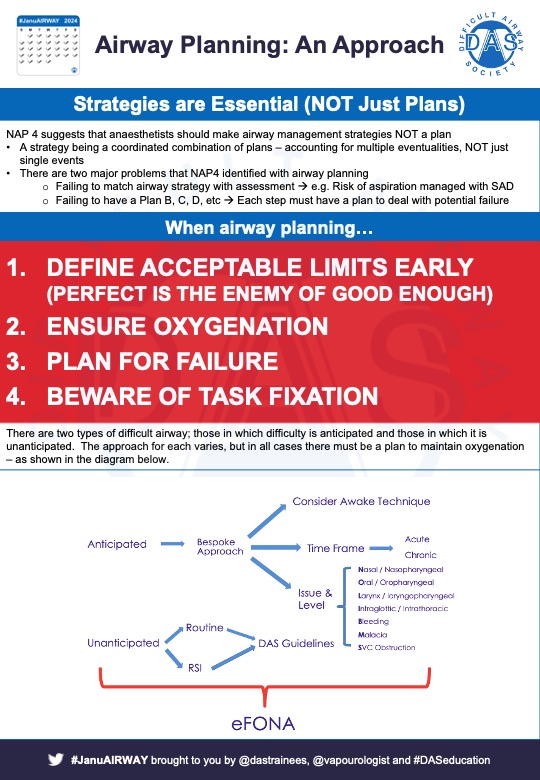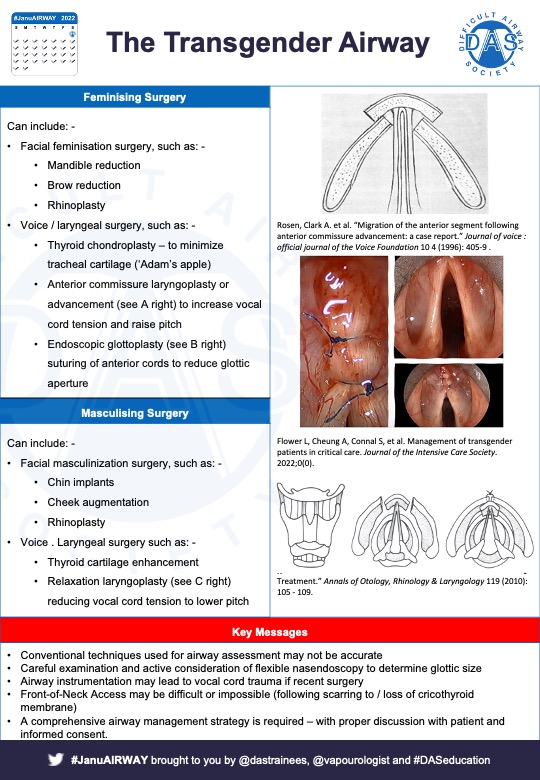#JanuAIRWAY Day 12. Awake Techniques (ft. expert contributions from @dr_imranahmad). This is a key skill for an airway manager. Here’s a #OnePager covering the basics of Awake Tracheal Intubation (ATI) and nasendoscopy. Let’s dive in…
#JanuAIRWAY 1/11
#JanuAIRWAY 1/11

Key = topicalization (if right, may not need sedation). Top tips:
- Know nerve supply CN V, IX & X.
- Block Ant.ethmoidal AND Sphenopalatine ganglion supply to the nasal septum
#JanuAIRWAY 2/11

- Know nerve supply CN V, IX & X.
- Block Ant.ethmoidal AND Sphenopalatine ganglion supply to the nasal septum
#JanuAIRWAY 2/11


Often you don’t need high dose LA if in right spot – this video is @Vapourologist after only gargling instilagel.
#JanuAIRWAY 3/11
#JanuAIRWAY 3/11
These #OnePagers cover ergonomics and the basics of the flexible bronchoscope.
- Know your equipment: set-up, usage and limitations
- Two positions for scope handling: Bazooka (facing patient) or Statue of Liberty (standing at head end)
#JanuAIRWAY 4/11



- Know your equipment: set-up, usage and limitations
- Two positions for scope handling: Bazooka (facing patient) or Statue of Liberty (standing at head end)
#JanuAIRWAY 4/11




Ancillary equipment can make or break an awake intubation. Here’s a #OnePager covering the 3 main types. Those which aid:
- Oxygen delivery
- Drug delivery
- Scope delivery (oral airways)
#JanuAIRWAY 5/11
- Oxygen delivery
- Drug delivery
- Scope delivery (oral airways)
#JanuAIRWAY 5/11

There are many different recipes for ATI. Here’s some #OnePagers looking at some of the different drugs that can be used, some special circumstances with additional considerations and another #OnePager summarising the DAS approach to ATI conduct.
#JanuAIRWAY 6/11


#JanuAIRWAY 6/11



There are a lot of potential problems that can be encountered during ATI – these need to be planned for. Here’s some #OnePagers covering the basics of troubleshooting, complications and how to manage unsuccessful ATI.
#JanuAIRWAY 7/11


#JanuAIRWAY 7/11



The DAS guidelines for Awake tracheal intubation are available in @Anaes_Journal #OpenAccess #FreeForever #RecommendedRead
🔓 …-publications.onlinelibrary.wiley.com/doi/10.1111/an…
#JanuAIRWAY 8/11
🔓 …-publications.onlinelibrary.wiley.com/doi/10.1111/an…
#JanuAIRWAY 8/11
Here are some other papers / links that you might find interesting:
🔗
🔗…-publications.onlinelibrary.wiley.com/doi/10.1111/an…
🔗
🔗
If you have any others of interest, tweet them to us for inclusion next time!
#JanuAIRWAY 9/11
🔗
🔗…-publications.onlinelibrary.wiley.com/doi/10.1111/an…
🔗
🔗
If you have any others of interest, tweet them to us for inclusion next time!
#JanuAIRWAY 9/11
Remember HFNO can help and a good knowledge of airway pharmacology is essential for awake techniques. Why not revisit our #OnePagers from #JanuAIRWAY Days 5 and 9.
Day 5 Airway Planning 🔗
Day 9 HFNO 🔗
#JanuAIRWAY 10/11
Day 5 Airway Planning 🔗
https://twitter.com/dastrainees/status/1478639924194729988?s=20
Day 9 HFNO 🔗
https://twitter.com/dastrainees/status/1480076519271768065?s=20
#JanuAIRWAY 10/11
Hope that helps. Tomorrow we'll take a look at Jet Ventilation. See you then!
#JanuAIRWAY 11/11
*Disclaimer: Inclusion of content (equipment, techniques and scoring systems etc.) in #JanuAIRWAY does not constitute DAS endorsement
#JanuAIRWAY 11/11
*Disclaimer: Inclusion of content (equipment, techniques and scoring systems etc.) in #JanuAIRWAY does not constitute DAS endorsement
• • •
Missing some Tweet in this thread? You can try to
force a refresh










